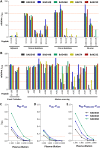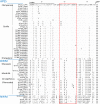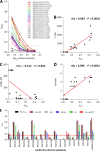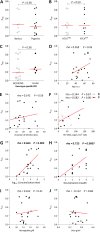An Immunodominant and Conserved B-Cell Epitope in the Envelope of Simian Foamy Virus Recognized by Humans Infected with Zoonotic Strains from Apes
- PMID: 30894477
- PMCID: PMC6532072
- DOI: 10.1128/JVI.00068-19
An Immunodominant and Conserved B-Cell Epitope in the Envelope of Simian Foamy Virus Recognized by Humans Infected with Zoonotic Strains from Apes
Abstract
Cross-species transmission of simian foamy viruses (SFVs) from nonhuman primates (NHPs) to humans is currently ongoing. These zoonotic retroviruses establish lifelong persistent infection in their human hosts. SFV are apparently nonpathogenic in vivo, with ubiquitous in vitro tropism. Here, we aimed to identify envelope B-cell epitopes that are recognized following a zoonotic SFV infection. We screened a library of 169 peptides covering the external portion of the envelope from the prototype foamy virus (SFVpsc_huHSRV.13) for recognition by samples from 52 Central African hunters (16 uninfected and 36 infected with chimpanzee, gorilla, or Cercopithecus SFV). We demonstrate the specific recognition of peptide N96-V110 located in the leader peptide, gp18LP Forty-three variant peptides with truncations, alanine substitutions, or amino acid changes found in other SFV species were tested. We mapped the epitope between positions 98 and 108 and defined six amino acids essential for recognition. Most plasma samples from SFV-infected humans cross-reacted with sequences from apes and Old World monkey SFV species. The magnitude of binding to peptide N96-V110 was significantly higher for samples of individuals infected with a chimpanzee or gorilla SFV than those infected with a Cercopithecus SFV. In conclusion, we have been the first to define an immunodominant B-cell epitope recognized by humans following zoonotic SFV infection.IMPORTANCE Foamy viruses are the oldest known retroviruses and have been mostly described to be nonpathogenic in their natural animal hosts. SFVs can be transmitted to humans, in whom they establish persistent infection, like the simian lenti- and deltaviruses that led to the emergence of two major human pathogens, human immunodeficiency virus type 1 and human T-lymphotropic virus type 1. This is the first identification of an SFV-specific B-cell epitope recognized by human plasma samples. The immunodominant epitope lies in gp18LP, probably at the base of the envelope trimers. The NHP species the most genetically related to humans transmitted SFV strains that induced the strongest antibody responses. Importantly, this epitope is well conserved across SFV species that infect African and Asian NHPs.
Keywords: antibody; emergence; retrovirus; zoonotic infections.
Copyright © 2019 American Society for Microbiology.
Figures








Similar articles
-
Potent neutralizing antibodies in humans infected with zoonotic simian foamy viruses target conserved epitopes located in the dimorphic domain of the surface envelope protein.PLoS Pathog. 2018 Oct 8;14(10):e1007293. doi: 10.1371/journal.ppat.1007293. eCollection 2018 Oct. PLoS Pathog. 2018. PMID: 30296302 Free PMC article.
-
Cocirculation of Two env Molecular Variants, of Possible Recombinant Origin, in Gorilla and Chimpanzee Simian Foamy Virus Strains from Central Africa.J Virol. 2015 Dec;89(24):12480-91. doi: 10.1128/JVI.01798-15. Epub 2015 Oct 7. J Virol. 2015. PMID: 26446599 Free PMC article.
-
Frequent simian foamy virus infection in persons occupationally exposed to nonhuman primates.J Virol. 2004 Mar;78(6):2780-9. doi: 10.1128/jvi.78.6.2780-2789.2004. J Virol. 2004. PMID: 14990698 Free PMC article.
-
Foamy virus zoonotic infections.Retrovirology. 2017 Dec 2;14(1):55. doi: 10.1186/s12977-017-0379-9. Retrovirology. 2017. PMID: 29197389 Free PMC article. Review.
-
Origin, evolution and innate immune control of simian foamy viruses in humans.Curr Opin Virol. 2015 Feb;10:47-55. doi: 10.1016/j.coviro.2014.12.003. Epub 2015 Feb 17. Curr Opin Virol. 2015. PMID: 25698621 Free PMC article. Review.
Cited by
-
Neutralization of zoonotic retroviruses by human antibodies: Genotype-specific epitopes within the receptor-binding domain from simian foamy virus.PLoS Pathog. 2023 Apr 24;19(4):e1011339. doi: 10.1371/journal.ppat.1011339. eCollection 2023 Apr. PLoS Pathog. 2023. PMID: 37093892 Free PMC article.
-
Plasma antibodies from humans infected with zoonotic simian foamy virus do not inhibit cell-to-cell transmission of the virus despite binding to the surface of infected cells.PLoS Pathog. 2022 May 23;18(5):e1010470. doi: 10.1371/journal.ppat.1010470. eCollection 2022 May. PLoS Pathog. 2022. PMID: 35605011 Free PMC article.
-
Seroprevalence of Feline Foamy Virus in Domestic Cats in Poland.J Vet Res. 2021 Oct 29;65(4):407-413. doi: 10.2478/jvetres-2021-0059. eCollection 2021 Dec. J Vet Res. 2021. PMID: 35111993 Free PMC article.
-
Comparative physiological anthropogeny: exploring molecular underpinnings of distinctly human phenotypes.Physiol Rev. 2023 Jul 1;103(3):2171-2229. doi: 10.1152/physrev.00040.2021. Epub 2023 Jan 5. Physiol Rev. 2023. PMID: 36603157 Free PMC article. Review.
-
The crystal structure of a simian Foamy Virus receptor binding domain provides clues about entry into host cells.Nat Commun. 2023 Mar 6;14(1):1262. doi: 10.1038/s41467-023-36923-0. Nat Commun. 2023. PMID: 36878926 Free PMC article.
References
Publication types
MeSH terms
Substances
LinkOut - more resources
Full Text Sources
Medical

